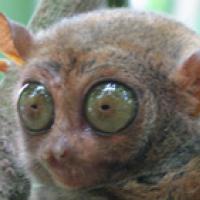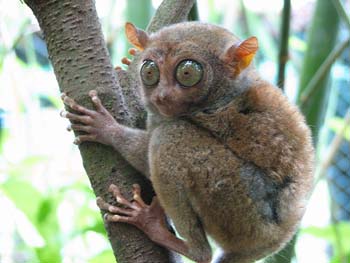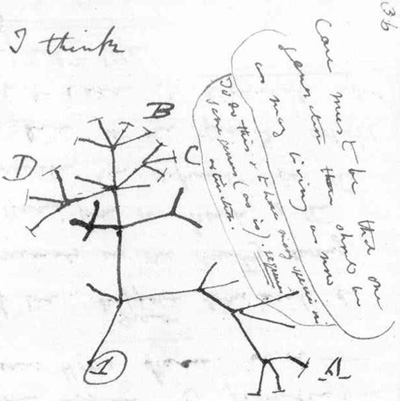
Evolution: It's as real as gravity!
Evolution is still all too often (but wrongly) downplayed as "just a theory" in public discussions. This is partly due to an unfortunate misunderstanding of what a theory means in science, as opposed to its common language meaning. Evolution by natural selection is much more than just a hypothesis, and is as much a valid and well-accepted scientific theory as the theory of gravitation. What Darwin did for biology is on par with what Newton did for physics — and mathematics plays an important role in both theories.

Evolution has produced wonderful animals, like this Philippine tarsier. Image mtoz, CC BY-SA 2.0.
If you look up the meaning of the word "theory" in the dictionary, it is described as being a synonym for words like "proposition", "hypothesis", or even "speculation". In contrast, a scientific theory is an established body of knowledge about a certain subject, supported by observable facts, repeatable experiments, and logical reasoning. A theory in science is a formal explanation of some aspect of the natural world, tested and verified by careful observation and experimentation. A good theory is one that also produces accurate and useful predictions.
As an example, let's consider gravitation.
Gravitation
In the 17th century, Isaac Newton formulated his law of gravitation, which explains the motions of objects under each other's gravitational influence. Newton's law can be used to predict the movements of the planets around the Sun, and NASA has used this same law to successfully land people on the Moon and send space probes to the outer edges of the solar system.
Newton's law of gravitation
Suppose you have two objects, say the Sun and the Earth, with masses $m_1$ and $m_2$ respectively. Write $r$ for the distance between the two objects. Then Newton's law says that the gravitational force $F$ between them is $$F=G_N\frac{m_1 m_2}{r^2},$$where $G_N$ is a fixed number, known as Newton's constant.
Yet Newton and many physicists after him could not explain what exactly gravity is or what causes it. Newton's theory was based on observing actual objects in motion, and then deducing general principles about their movements that are logically consistent with these observations.
By the beginning of the 20th century, however, it had become clear that Newton's law did not hold up under all circumstances. When it comes to planets or falling apples, Newton's theory of gravitation is perfectly adequate. But when objects move at velocities close to the speed of light, for example, this theory does not produce accurate predictions anymore. Albert Einstein extended Newton's law with his general theory of relativity, which accounted for these discrepancies.

Isaac Newton (1643 - 1727).
During the 1960s, physicist Peter Higgs and others postulated the existence of an elementary particle, now known as the Higgs boson, that would explain why some elementary particles have mass. Mass is of course directly related to gravity: both Newton and Einstein tell us that it's massive bodies which exert a gravitational pull. Thus, a prediction from particle physics provided a deeper insight into the workings of gravity. The postulation of the Higgs boson was purely based on mathematical reasoning, as there was then no way of actually observing such a particle. However, just a few years ago, CERN announced that they had confirmed this prediction with their multi-million dollar particle collider.
The theory of gravitation is a well-established scientific theory, supported by observational and experimental evidence. It explains something about the natural world, and can be directly applied to obtain useful results. Over the years, the theory has been extended and refined (as part of the usual scientific process), but the basic ideas and principles have withstood the test of time.
Now let's have a look at evolution.
Evolution
In the 19th century, Charles Darwin formulated his theory of evolution by natural selection. The fact that species change (evolve) over time was not new, as this was already well accepted among Darwin's scientific contemporaries. However, what Darwin provided was a new and logical explanation of how this process of evolution happens.

Charles Darwin (1809 - 1882).
Offspring inherit their characteristics from their parents, but with small (and mostly random) variations. However, most organisms have far more than one offspring, resulting in competition for resources and healthy mates among individuals between and within species. This, in turn, gives rise to a natural selection process where, on average, individuals with advantageous variations (making them more likely to survive and secure a healthy mate) will have more offspring than others. This way, such advantageous variations are passed on to subsequent generations more often — thus spreading through the population — than disadvantageous variations, which are "weeded out". Over long time spans, the accumulation of such adaptations can eventually result in a speciation event, for example when a population of related organisms splits into two geographically isolated ones, which subsequently evolve in different directions.
Yet Darwin and many biologists after him could not explain how exactly organisms inherit their characteristics from their parents. Darwin's insights were based on observing and comparing actual organisms in nature (including fossils), and then deducing general principles of their evolution that are logically consistent with these observations.
Darwin's theory of evolution, however, still fell short in certain aspects. For example, it did not provide any quantitative predictions. During the first half of the 20th century, though, the mathematical theory of population genetics was developed. This theory provides accurate predictions about, for example, how fast a new variation (genetic mutation) will spread through a population. Soon after, Darwin's theory and population genetics were married into what is known as the new evolutionary synthesis (or modern synthesis).
In 1944, the physicist Erwin Schrödinger published his book What is life?, in which he postulated the existence of a certain kind of molecule, referring to it as an aperiodic crystal, that would form the basis of genetics, which is directly related to inheritance. Thus, a prediction about chemistry provided a deeper insight into the workings of evolution. Schrödinger's postulation was purely based on logical reasoning, as he had no means of actually observing the structure of such a molecule. In 1953, however, his prediction was confirmed with the discovery of the structure of DNA by James Watson and Francis Crick. This discovery eventually led to cracking the genetic code.

Being bright blue might help you secure a mate and spread your genes.
These days, evolutionary theory is used in many practical applications. For example, when a new virus appears somewhere in, say, Asia, scientists use phylogenetic and population genetics models to predict how this virus might evolve, so they can try to create the most effective vaccine by the time the virus reaches Europe or the US (phylogenetics is the study of evolutionary history). Mathematics plays an essential role here, without which these predictions could not be made. See below for a brief overview of the mathematics behind phylogenetics.
Also, evolution-based methods are used in the laboratory to find better medicines for various illnesses, or in computer programs to find good solutions to difficult optimisation problems. And environmental policies are increasingly based on evolutionary (in particular phylogenetic) analyses to make decisions about species preservation efforts, to name just a few.
The theory of evolution is a well-established scientific theory, supported by observational and experimental evidence. It explains something about the natural world, and can be directly applied to obtain useful results. Over the years, the theory has been (and still is being) extended and refined, but the basic ideas and principles have withstood the test of time.
Of course the above story is only a brief summary, with many of the finer details and contributing scientists left out. But note the striking similarities between the theories of gravitation and evolution, both in terms of their development over time as well as their practical applicability. Evolution clearly is not "just a hypothesis". It is as much a valid scientific theory as the theory of gravitation. And nobody in their right mind would claim that gravity is not real, or that Newton was wrong. So why would anyone claim that evolution is not real, or that Darwin was wrong?
The maths of phylogenetics
As mentioned above, the idea of evolution (as in "change over time") was already accepted among many biologists in Darwin's time. But the way most scientists thought of evolution was in terms of independent lineages. In other words, horses evolve, but remain horses. And the same for tulips, pigeons, herrings, or any other species out there.
However, one of Darwin's great insights was that evolution is a branching process. In other words, a species can change and diversify to such an extend that it eventually splits into two species (for instance due to geographic separation), each of which then continues to evolve on its own. For example, humans and chimps evolved from a common ancestral ape species that lived some 6-7 million years ago, and all currently living bird species have their common ancestry within a group of dinosaurs known as theropoda which lived during the Jurassic period (145-200 million years ago).
As a consequence, evolution can be depicted as a tree, where currently living species (the leaves of the tree) are connected by branches via their common ancestors. The earliest common ancestor to all other species forms the root of the tree. Such an evolutionary tree is often referred to as a phylogenetic tree. One of the first phylogenetic trees ever drawn was by Darwin himself in one of his notebooks from 1837.

Darwin's first sketch of a (hypothetical) phylogenetic tree (1837).
One big problem with reconstructing phylogenetic trees, however, is that there are many ways in which such a tree could be drawn, even though only one of them can be the "true tree", depicting the correct evolutionary relationships between a group of species. For example, for the three species man, ape, and dog, a phylogenetic tree can be drawn in three different ways (note that phylogenetic trees are often drawn upside down, i.e., with the root at the top):

The three possible ways of drawing a phylogenetic tree on three species.
In this case it is clear that only the tree on the right can be the correct one, as we know that man and ape are evolutionary more closely related to each other (i.e., they share a more recent common ancestor) than either of them is to dog. But for five species the number of possible trees is already more than a hundred, and for ten species it is more than 30 million!
In general, for $n$ species there are $$(2n-3)!! = (2n-3) \times (2n-5) \times (2n-7) \times ... \times 3 \times 1$$ possible (rooted) binary trees (see here to see the calculation). The expression above is called a double factorial, you can find out more here. So, the problem is how to decide which one of these many possible trees on a given number of species is actually the correct one.

Horses don't necessarily always stay horses.
The easiest (and fastest) way to construct a phylogenetic tree is to simply calculate distances between pairs of species. For example, given genetic data such as DNA sequences, the distance between two species can be calculated as the number of nucleotide sites in their respective DNA sequences where they differ. This results in a tree where the species with the shortest distances between them share the most recent common ancestors (such as man and ape above). However, this method assumes that mutations (i.e., evolutionary changes) happen with a fixed probability over time and across the DNA sequence. Unfortunately this is too simplistic of an assumption, and can easily result in a wrong tree.
Instead, sophisticated probabilistic models of how evolution happens are used, including the possibility that mutations can happen with different probabilities over time and space. Maximum likelihood methods are then used to estimate the model parameters and to evaluate how accurately a given phylogenetic tree fits the actual (genetic) data. Finally, given that we cannot exhaustively evaluate all possible trees, heuristic optimisation methods are used to try and find a tree that is reasonably accurate. Mathematicians and computer scientists are currently still working on improving these methods, especially given the ever increasing availability of genetic data.
Another difficult issue is that evolution cannot always be depicted as a tree in which each species is connected to exactly one ancestor. For example, some plant species have evolved through hybridisation, in which the genetic material of two different ancestral species is combined into one descendant species. Also, many bacteria, even from different species, regularly exchange genetic material directly (called horizontal gene transfer), independent of any reproduction. These cases are known as reticulate events, and cannot be captured by a proper tree structure. Instead, the more general concept of a phylogenetic network is required, which is also a topic of active research.
The ultimate goal of phylogenetics is to have a complete Tree of Life containing all known species and their ancestral (evolutionary) relationships. This would connect all species, current and past, through their individual but converging ancestral lineages back to the common ancestor of all life on Earth. As Darwin wrote at the end of his famous book: "There is grandeur in this view of life, with its several powers, having been originally breathed into a few forms or into one; and that, whilst this planet has gone cycling on according to the fixed law of gravity, from so simple a beginning endless forms most beautiful and most wonderful have been, and are being, evolved." It seems that mathematics can make a significant contribution to this grand view of life.

An English version of Ernst Haeckel's tree from the The Evolution of Man.
Further reading
You can find out more about the maths of phylogenetics in Reconstructing the tree of life.
About the author
Wim Hordijk is a computer scientist currently on a fellowship at the Konrad Lorenz Institute in Klosterneuburg, Austria. He has worked on many research and computing projects all over the world, mostly focusing on questions related to evolution and the origin of life. More information about his research can be found on his website.
Comments
Guest
"For example, when a new virus appears somewhere in, say, Asia, scientists use phylogenetic and population genetics models to predict how this virus might evolve, so they can try to create the most effective vaccine by the time the virus reaches Europe or the US."
But not to protect the billions of potential patients that exist in the entire continent of "Asia" who have yet to be infected or, indeed, to find a cure for those billions of Asians already infected? Just so long as an effective vaccine is found to stop any *Europeans* or those in the *US* even contracting the disease in the first place. That is what is the concern of scientists when a virus emerges in Asia?
Jeff Navarro
Why must you infer racism?? It's merely an example of how evolutionary theory has a practical use.
The virus discovered in Asia has not evolved yet, so scientists don't need to anticipate what vaccine they'll need, as they will after it mutates on its way to other countries...they can already make the correct vaccine for Asians.
Banibal123
There is only observable evidence for micro evolution i.e. a bird evolving into another type of bird. There are NO experiments and no evidence that show macro evolution, for example that a horse eventually evolved into a giraffe.
To compare evolution to gravity is a cheap trick to shut down criticism against the theory of evolution, which more scientists than you think actually have criticized.
John Williams
While scientists admit that they really don't know about two important factors in the development of galaxies in the universe, namely dark matter and dark energy, evolution is left behind a much easier to inspect historical crime scene. Evolution makes very exact predictions about what we will find in the historical evidence and very little surprises us in terms of our fossil record, DNA, mutation and selection. When we look beyond our own galaxy we are still surprised by what we find. Galaxies too light to be held together, galaxies accelerating away from each other.
Wim Hordijk
There is plenty of evidence that fish crawled out of the water and evolved into land animals, some of which then returned to the water and eventually evolved, for example, into dolphins and whales (which are not fish but mammals!). And, as mentioned in the article, birds evolved from dinosaurs. A visit to a good museum of natural history will show you much of this evidence.
Clay Prince
There is zero “evidence” of the above declaration, enthusiasm and supposition among scientists with credentials on the line notwithstanding. Try this: make any assumption about the size of the original genome and divide by 1,000. Assume that to be the genomic problem set. Assume 1/10 of the problem set to be relevant in placement on the genome for survival and reproduction. Calculate the probability of proper placement within the problem set. Calculate the time required to empirically iterate to proper placement at a rate one petaflops per second. (All of the foregoing can be performed with online calculators.) Repeat the above calculation for the cell membrane required for cellular survival. Repeat once more for the probability of the cell membrane matching the genome. Add the three times together and divide the total by 13.7 billion. That’s how many times longer than the universe has existed would be required to “evolve” a tiny fraction of the common genome at a rate of one thousand trillion attempts per second. Evolutionists are the most self-deluded people on planet earth.
John Jaeger
1. Random mutation, and then
2. "Selection".
If you don't buy into this inane tautology, then "you don't understand evolution. It's simply too complicated a branch of fake science for you.
There could not be thousands of papers, hundreds of books and videos and lectures challenging the archaic notion proposed by Darwin and earlier by others. "A new scientific truth does not advance by convincing its opponents, and making them see the light, but rather because its opponents eventually die." - Max Planck